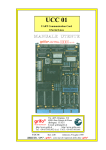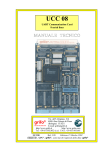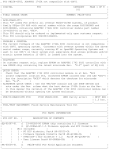Download MVIP302 Eight-Channel EIA-232 IndustryPack® and MVIP303 Eight
Transcript
MVIP302 Eight-Channel EIA-232 IndustryPack¨ and MVIP303 Eight-Channel EIA-422 IndustryPack¨ User’s Manual (MVIP302/D1) Notice While reasonable efforts have been made to assure the accuracy of this document, Motorola, Inc. assumes no liability resulting from any omissions in this document, or from the use of the information obtained therein. Motorola reserves the right to revise this document and to make changes from time to time in the content hereof without obligation of Motorola to notify any person of such revision or changes. No part of this material may be reproduced or copied in any tangible medium, or stored in a retrieval system, or transmitted in any form, or by any means, radio, electronic, mechanical, photocopying, recording or facsimile, or otherwise, without the prior written permission of Motorola, Inc. It is possible that this publication may contain reference to, or information about Motorola products (machines and programs), programming, or services that are not announced in your country. Such references or information must not be construed to mean that Motorola intends to announce such Motorola products, programming, or services in your country. Restricted Rights Legend If the documentation contained herein is supplied, directly or indirectly, to the U.S. Government, the following notice shall apply unless otherwise agreed to in writing by Motorola, Inc. Use, duplication, or disclosure by the Government is subject to restrictions as set forth in subparagraph (c)(1)(ii) of the Rights in Technical Data and Computer Software clause at DFARS 252.227-7013. Motorola, Inc. Computer Group 2900 South Diablo Way Tempe, Arizona 85282 Preface Much of the information in the MVIP302 Eight Channel EIA-232 IndustryPack and MVIP303 Eight Channel EIA-422 IndustryPack UserÕs Manual is adapted from the IPOctal Serial User Manual and the IP-Octal 422 User Manual, published by GreenSpring Computers, Inc. Permission to reproduce this material has been granted by GreenSpring Computers, Inc. The following Motorola publication is referenced in this manual. If not shipped with this product, it may be purchased by contacting your local Motorola sales ofÞce. Document Title Motorola Publication Number MVME162 Embedded Controller UserÕs Manual MVME162/D This manual also references the IndustryPack Interface SpeciÞcation. The SpeciÞcation may be purchased from: VITA-USA, 10229 N. Scottsdale Rd., Ste. B, Scottsdale, Az. 85253-1437; (602) 951-8866. Motorola¨ and the Motorola symbol are registered trademarks of Motorola, Inc. IndustryPack¨ is a registered trademark of GreenSpring Computers, Inc. All other products mentioned in this document are trademarks or registered trademarks of their respective holders. © Copyright Motorola 1993 All Rights Reserved Printed in the United States of America June 1993 Safety Summary Safety Depends On You The following general safety precautions must be observed during all phases of operation, service, and repair of this equipment. Failure to comply with these precautions or with speciÞc warnings elsewhere in this manual violates safety standards of design, manufacture, and intended use of the equipment. Motorola, Inc. assumes no liability for the customer's failure to comply with these requirements. The safety precautions listed below represent warnings of certain dangers of which Motorola is aware. You, as the user of the product, should follow these warnings and all other safety precautions necessary for the safe operation of the equipment in your operating environment. Do Not Operate in an Explosive Atmosphere. Do not operate the equipment in the presence of ßammable gases or fumes. Operation of any electrical equipment in such an environment constitutes a deÞnite safety hazard. Keep Away From Live Circuits. Operating personnel must not remove equipment covers. Only Factory Authorized Service Personnel or other qualiÞed maintenance personnel may remove equipment covers for internal subassembly or component replacement or any internal adjustment. Do not replace components with power cable connected. Under certain conditions, dangerous voltages may exist even with the power cable removed. To avoid injuries, always disconnect power and discharge circuits before touching them. Do Not Service or Adjust Alone. Do not attempt internal service or adjustment unless another person, capable of rendering Þrst aid and resuscitation, is present. Do Not Substitute Parts or Modify Equipment. Because of the danger of introducing additional hazards, do not install substitute parts or perform any unauthorized modiÞcation of the equipment. Contact your local Motorola representative for service and repair to ensure that safety features are maintained. Dangerous Procedure Warnings. Warnings, such as the example below, precede potentially dangerous procedures throughout this manual. Instructions contained in the warnings must be followed. You should also employ all other safety precautions which you deem necessary for the operation of the equipment in your operating environment. ! WARNING Dangerous voltages, capable of causing death, are present in this equipment. Use extreme caution when handling, testing, and adjusting. ! WARNING ! WARNING This equipment generates, uses, and can radiate radio frequency energy and if not installed and used in accordance with the documentation for this product, may cause interference to radio communications. It has been tested and found to comply with the limits for a Class A Computing Device pursuant to Subpart J of Part 15 of FCC rules, which are designed to provide reasonable protection against such interference when operated in a commercial environment. Operation of this equipment in a residential area is likely to cause interference in which case the user, at the userÕs own expense, will be required to take whatever measures necessary to correct the interference. Motorola products are not authorized for use as components in life support devices or systems intended for surgical implant into the body or intended to support or sustain life. Buyer agrees to notify Motorola of any such intended end use whereupon Motorola shall determine availability and suitability of its product or products for the use intended. Contents Chapter 1 PRODUCT DESCRIPTION Introduction ..........................................................................................................1-1 General Description .............................................................................................1-1 MVIP302..........................................................................................................1-1 MVIP303..........................................................................................................1-4 Chapter 2 ADDRESSING Introduction ..........................................................................................................2-1 VMEbus Addressing............................................................................................2-1 Chapter 3 I/O PIN ASSIGNMENTS Introduction ..........................................................................................................3-1 MVIP302 EIA-232 I/O Pin Assignments ..........................................................3-1 MVIP303 EIA-422 I/O Pin Assignments ..........................................................3-4 Chapter 4 LOGIC INTERFACE PIN ASSIGNMENTS Introduction ..........................................................................................................4-1 Pin Assignments ...................................................................................................4-1 Chapter 5 PROGRAMMING Introduction ..........................................................................................................5-1 Programming the MVIP302/MVIP303 .............................................................5-1 Chapter 6 ID PROM Introduction ..........................................................................................................6-1 ID PROM ...............................................................................................................6-1 Chapter 7 USER OPTIONS Introduction ..........................................................................................................7-1 vii Strobe Connection Options................................................................................. 7-4 Direct Memory Access (DMA) Options............................................................ 7-4 Appendix A SPECIFICATIONS Construction and Reliability ............................................................................. A-1 SpeciÞcations ....................................................................................................... A-2 viii Figures Figure 1-1. Figure 1-2. Figure 1-3. Figure 4-1. Figure 4-2. Figure 7-1. Figure 7-2. SimpliÞed Block Diagram of the MVIP302 ..................................1-2 MVIP302 I/O Buffer Circuit...........................................................1-3 SimpliÞed Block Diagram of the MVIP303 ..................................1-5 Logic Interface Pin Assignments for the MVIP302 .....................4-2 Logic Interface Pin Assignments for the MVIP303 .....................4-3 MVIP302 Header Location Diagram.............................................7-2 MVIP303 Header Location Diagram.............................................7-3 ix x Tables Table 2-1. Register Map of SCC2698, Blocks A and B......................................2-2 Table 2-2. Register Map of SCC2698, Blocks C and D.....................................2-3 Table 3-1. MVIP302 EIA-232 I/O PIn Assignments ........................................3-2 Table 3-2. MVIP303 EIA-422 I/O Pin Assignments.........................................3-4 Table 6-1. ID PROM Data (hex) ..........................................................................6-2 Table 7-1. Strobe Connection Options ...............................................................7-4 Table 7-2. DMA Jumper ConÞgurations ...........................................................7-4 xi xii PRODUCT DESCRIPTION 1 Introduction The MVIP302 and MVIP303 are part of the IndustryPack family of modular I/O components. They are based around the Signetics CMOS SCC2698 Octal Universal Asynchronous Receiver/Transmitter. This component provides eight channels of full-duplex asynchronous serial communications, baud rate generators, state change detect logic, and four 16-bit counter/timers. A block diagram of the MVIP302 is shown in Figure 1-1; Figure 1-2 illustrates the MVIP302 I/O Buffer Circuit. A block diagram of the MVIP303 is shown in Figure 1-3. General Description MVIP302 EIA-232-D communication levels are provided by CMOS MC14C88 and MC14C89 transmitters and receivers. Five signals for each channel on the EIA232-D interface are supported: Transmit Data (TxD), Receive Data (RxD), Ready-To-Send (RTS), Clear-To-Send (CTS) and ground. The MC14C89 Receivers are biased at 1.5 volts nominally to permit a variety of input signal levels to be received without additional interface circuitry (see Figure 1-2). Protection diodes are provided in the ±12 volt supply lines to permit connection to powered equipment, even if the IndustryPack is unpowered. Vectored interrupts are fully supported. A common 8-bit vector register is provided. Channels a,b,c,d interrupt on IRQ0; channels e,f,g,h interrupt on IRQ1. DMA is supported on channels c and d. If DMA is used, then the Request-ToSend lines on these two channels are not available . The IndustryPack is controlled by a single CMOS 22V10 type PAL. Connection to the MVIP302 is via a standard 50-conductor ribbon cable. 1 Product Description ONE OF EIGHT CHANNELS 8 EIA-232-D OCTART LOGIC INTERFACE ID PROM SCC2698B CONTROL PAL EIGHT GENERAL PURPOSE INPUTS VECTOR REGISTER 10430.00 9306 Figure 1-1. Simplified Block Diagram of the MVIP302 1-2 MVIP302/MVIP303 UserÕs Manual General Description +12V EIA-232-D SIGNAL OUT FROM OCTART -12V TO OCTART EIA-232-D SIGNAL IN 22KΩ -12V 10431.00 93066 Figure 1-2. MVIP302 I/O Buffer Circuit MVIP302/D1 1-3 1 1 Product Description MVIP303 EIA-422 communication levels are provided by 26LS31 and 26LS32 transmitters and receivers. Differential transmit data (TxD) and receive data (RxD) lines are provided, plus ground. EIA-422 communication is preferred over EIA-232 because it provides significantly higher noise immunity. A second advantage is that no ±12 volt power is required at either the send or receive end. Vectored interrupts are fully supported. A common 8-bit vector register is provided. Channels a,b,c,d interrupt on IRQ0. Channels e,f,g,h interrupt on IRQ1. DMA is supported on channels c and d. The IndustryPack is controlled by a single CMOS 22V10 type PAL. Connection to the MVIP303 is via a standard 50-conductor ribbon cable. 1-4 MVIP302/MVIP303 UserÕs Manual General Description ONE OF EIGHT CHANNELS + 8 OCTART + LOGIC INTERFACE ID PROM EIA-422 EIA-422 SCC2698B CONTROL PAL EIGHT GENERAL PURPOSE INPUTS VECTOR REGISTER 10432.00 9306 Figure 1-3. Simplified Block Diagram of the MVIP303 MVIP302/D1 1-5 1 ADDRESSING 2 Introduction The MVIP302 and MVIP303 are accessed using 8-bit bytes at odd locations only. They are usually accessed in the I/O space. Table 2-1 and Table 2-2 show the register maps of the MVIP302 and MVIP303. All addresses are offsets from the I/O base address of the IP, as set on the IP carrier board. VMEbus Addressing The SCC2698B Octal UART has four major internal sections, called functional blocks A through D. Each functional block has two serial channels, one timer, and one I/O port. Addressing 2 Table 2-1. Register Map of SCC2698, Blocks A and B Hex Dec Binary Read Write Functional Block A 1 1 0000001 MR1a, MR2a 3 3 0000011 SRa MR1a, MR2a CSRa 5 5 0000101 RESERVED CRa 7 7 0000111 RHRa THRa 9 9 0001001 IPCRA ACRA B 11 0001011 ISRA IMRA D 13 0001101 CTUA CTURA F 15 0001111 CRLB CTLRB 11 17 0010001 MR1b, MR2b MR1b, MR2b 13 19 0010011 SRb CSRb 15 21 0010101 RESERVED CRb 17 23 0010111 RHRb RHRb 19 25 0011001 RESERVED RESERVED 1B 27 0011011 INPUT PORT A OPCRA 1D 29 0011101 START C/T A RESERVED 1F 31 0011111 STOP C/T A RESERVED 21 33 0100001 MR1c, MR2c MR1c, MR2c 23 35 0100011 SRc CSRc 25 37 0100101 RESERVED CRc 27 39 0100111 RHRc THRc 29 41 0101001 IPCRB ACRB 2B 43 0101011 ISRB IMRB 2D 45 0101101 CTUB CTURB 2F 47 0101111 CRLB CTLRB 31 49 0110001 MR1d, MR2d MR1d, MR2d 33 51 0110011 SRd CSRd 35 53 0110101 RESERVED CRd 37 55 0110111 RHRd THRd 39 57 0111001 RESERVED RESERVED 3B 59 0111011 INPUT PORT B OPCRB 3D 61 0111101 START C/T B RESERVED 3F 63 0111111 STOP C/T B RESERVED Functional Block B 2-2 MVIP302/MVIP303 UserÕs Manual VMEbus Addressing Table 2-2. Register Map of SCC2698, Blocks C and D Hex Dec Binary Read 2 Write Functional Block C 41 65 1000001 MR1e, MR2e MR1e, MR2e 43 67 1000011 SRe CSRe 45 69 1000101 RESERVED CRe 47 71 1000111 RHRe THRe 49 73 1001001 IPCRC ACRC 4B 75 1001011 ISRC IMRC 4D 77 1001101 CTUC CTURC 4F 79 1001111 CRLC CTLRC 51 81 1010001 MR1f, MR2f MR1f, MR2f 53 83 1010011 SRf CSRf 55 85 1010101 RESERVED CRf 57 87 1010111 RHRf THRf 59 89 1011001 RESERVED RESERVED 5B 91 1011011 INPUT PORT C OPCRC 5D 93 1011101 START C/T C RESERVED 5F 95 1011111 STOP C/T C RESERVED 61 97 1100001 MR1g, MR2g MR1g, MR2g 63 99 1100011 SRg CSRg 65 101 1100101 RESERVED CRg 67 103 1100111 RHRg THRg 69 105 1101001 IPCRD ACRD 6B 107 1101011 ISRD IMRD 6D 109 1101101 CTUD CTURD 6F 111 1101111 CRLD CTLRD 71 113 1110001 MR1h, MR2h MR1h, MR2h 73 115 1110011 SRh CSRh 75 117 1110101 RESERVED CRh 77 119 1110111 RHRh RHRh 79 121 1111001 RESERVED RESERVED 7B 123 1111011 INPUT PORT D OPCRD 7D 125 1111101 START C/T D RESERVED 7F 127 1111111 STOP C/T D RESERVED Functional Block D MVIP302/D1 2-3 I/O PIN ASSIGNMENTS 3 Introduction This chapter discusses EIA-232 and EIA-422 I/O Pin Assignments. The MVIP302 EIA-232 I/O wiring pin assignments are shown in Table 3-1; the MVIP303 EIA-422 I/O pin assignments are shown in Table 3-2. MVIP302 EIA-232 I/O Pin Assignments Each channel has five EIA-232-D lines, and each is wired identically at the 50pin connector. The five lines are Ground, Transmit Data output, Receive Data input, Ready to Send output, and Clear to Send input. The common ground line for all channels connects to the local logic ground. There are many programming options. The two modem control lines, RTS and CTS, may also be used for other modem or terminal control functions or for general purpose functions. There is a pullup resistor (1KΩ) to +12 volts available on pin 42. This may be connected externally to assert a ÒMarkÓ (true) signal into an EIA-232-D line. Eight general purpose input lines at non-EIA-232 levels are provided on pins 43 through 50. These are unbuffered CMOS logic inputs connected directly to the SCC2698B. They may be programmed as general purpose inputs or as the counter/timer external input. The switching threshold for inputs is at TTL levels (1.5 volts nominal). C aution Because these lines are unbuffered, you are cautioned to observe anti-static rules in handling cabling, the IndustryPack and all connecting hardware. External equipment connected to these lines should be powered up and down at the same time as the IndustryPack. I/O Pin Assignments Table 3-1. MVIP302 EIA-232 I/O PIn Assignments 3 3-2 Pin Number Channel Function Level 1 Channel a GND EIA-232-D 2 Channel a TxD EIA-232-D 3 Channel a RxD EIA-232-D 4 Channel a RTS EIA-232-D 5 Channel a CTS EIA-232-D 6 Channel b GND EIA-232-D 7 Channel b TxD EIA-232-D 8 Channel b RxD EIA-232-D 9 Channel b RTS EIA-232-D 10 Channel b CTS EIA-232-D 11 Channel c GND EIA-232-D 12 Channel c TxD EIA-232-D 13 Channel c RxD EIA-232-D 14 Channel c RTS EIA-232-D 15 Channel c CTS EIA-232-D 16 Channel d GND EIA-232-D 17 Channel d TxD EIA-232-D 18 Channel d RxD EIA-232-D 19 Channel d RTS EIA-232-D 20 Channel d CTS EIA-232-D 21 Channel e GND EIA-232-D 22 Channel e TxD EIA-232-D 23 Channel e RxD EIA-232-D 24 Channel e RTS EIA-232-D 25 Channel e CTS EIA-232-D 26 Channel f GND EIA-232-D 27 Channel f TxD EIA-232-D MVIP302/MVIP303 UserÕs Manual MVIP302 EIA-232 I/O Pin Assignments Table 3-1. MVIP302 EIA-232 I/O PIn Assignments Pin Number Channel Function Level 28 Channel f RxD EIA-232-D 29 Channel f RTS EIA-232-D 30 Channel f CTS EIA-232-D 31 Channel g GND EIA-232-D 32 Channel g TxD EIA-232-D 33 Channel g RxD EIA-232-D 34 Channel g RTS EIA-232-D 35 Channel g CTS EIA-232-D 36 Channel h GND EIA-232-D 37 Channel h TxD EIA-232-D 38 Channel h RxD EIA-232-D 39 Channel h RTS EIA-232-D 40 Channel h CTS EIA-232-D 41 -- GND -- 42 -- +12 pullup EIA-232-D 43 Channel a MPI - a CMOS* 44 Channel b MPI - b CMOS* 45 Channel c MPI - c CMOS* 46 Channel d MPI - d CMOS* 47 Channel e MPI - e CMOS* 48 Channel f MPI - f CMOS* 49 Channel g MPI - g CMOS* 50 Channel h MPI - h CMOS* 3 *Note: I/O lines on pins 43-50 are +/-50 µA input current, TTL thresholds. MVIP302/D1 3-3 I/O Pin Assignments MVIP303 EIA-422 I/O Pin Assignments Each channel has five lines, and each is wired identically at the 50-pin connector. The five lines are: Ground, Transmit Data output Minus, Transmit Data output Plus, Receive Data input Minus, and Receive Data input Plus. The common ground line for all channels connects to the local logic ground. 3 Eight general purpose input lines at non-EIA-422 levels are provided on pins 43 through 50. These are unbuffered CMOS logic inputs connected directly to the SCC2698B. They may be programmed as general purpose inputs or as the counter/timer external input. The switching threshold for inputs is at TTL levels (1.5 volts nominal). C aution Because these lines are unbuffered, you are cautioned to observe anti-static rules in handling cabling, the IndustryPack and all connecting hardware. External equipment connected to these lines should be powered up and down at the same time as the IndustryPack. Table 3-2. MVIP303 EIA-422 I/O Pin Assignments 3-4 Pin Number Channel Function Level 1 2 Channel a GND EIA-422 Channel a TxDÐ EIA-422 3 Channel a TxD+ EIA-422 4 Channel a RxDÐ EIA-422 5 Channel a RxD+ EIA-422 6 Channel b GND EIA-422 7 Channel b TxDÐ EIA-422 8 Channel b TxD+ EIA-422 9 Channel b RxDÐ EIA-422 10 Channel b RxD+ EIA-422 11 Channel c GND EIA-422 12 Channel c TxDÐ EIA-422 13 Channel c TxD+ EIA-422 14 Channel c RxDÐ EIA-422 MVIP302/MVIP303 UserÕs Manual MVIP303 EIA-422 I/O Pin Assignments Table 3-2. MVIP303 EIA-422 I/O Pin Assignments MVIP302/D1 Pin Number Channel Function Level 15 Channel c RxD+ EIA-422 16 Channel d GND EIA-422 17 Channel d TxDÐ EIA-422 18 Channel d TxD+ EIA-422 19 Channel d RxDÐ EIA-422 20 Channel d RxD+ EIA-422 21 Channel e GND EIA-422 22 Channel e TxDÐ EIA-422 23 Channel e TxD+ EIA-422 24 Channel e RxDÐ EIA-422 25 Channel e RxD+ EIA-422 26 Channel f GND EIA-422 27 Channel f TxDÐ EIA-422 28 Channel f TxD+ EIA-422 29 Channel f RxDÐ EIA-422 30 Channel f RxD+ EIA-422 31 Channel g GND EIA-422 32 Channel g TxDÐ EIA-422 33 Channel g TxD+ EIA-422 34 Channel g RxDÐ EIA-422 35 Channel g RxD+ EIA-422 36 Channel h GND EIA-422 37 Channel h TxDÐ EIA-422 38 Channel h TxD+ EIA-422 39 Channel h RxDÐ EIA-422 40 Channel h RxD+ EIA-422 41 -- GND -- 3 3-5 I/O Pin Assignments Table 3-2. MVIP303 EIA-422 I/O Pin Assignments 3 Pin Number Channel Function Level 42 -- no connection 43 Channel a MPI - a CMOS* 44 Channel b MPI - b CMOS* 45 Channel c MPI - c CMOS* 46 Channel d MPI - d CMOS* 47 Channel e MPI - e CMOS* 48 Channel f MPI - f CMOS* 49 Channel g MPI - g CMOS* 50 Channel h MPI - h CMOS* *Note: I/O lines on pins 43-50 are +/-50 µA input current, TTL thresholds. 3-6 MVIP302/MVIP303 UserÕs Manual LOGIC INTERFACE PIN ASSIGNMENTS 4 Introduction This chapter provides information on the pin assignments for the MVIP302 (see Figure 4-1) and the MVIP303 (see Figure 4-2). Pin Assignments Pins marked n/c are defined by the IndustryPack Interface Specification, but not used on the MVIP302 or the MVIP303. Pin Assignments 4 GND 1 26 GND CLK 2 27 +5V Reset* 3 28 R/W* D0 4 29 IDSel* D1 5 30 DMAReq0 D2 6 31 MEMSel* D3 7 32 DMAReq1 D4 8 33 INTSel* D5 9 34 DMAck0* D6 10 35 IOSel* D7 11 36 DMAck1* n/c 12 37 A1 n/c 13 38 n/c n/c 14 39 A2 n/c 15 40 n/c n/c 16 41 A3 n/c 17 42 nc n/c 18 43 A4 n/c 19 44 n/c n/c 20 45 A5 n/c 21 46 Strobe* -12V 22 47 A6 +12V 23 48 Ack* +5V 24 49 n/c GND 25 50 GND Note 1 : The no-connect (n/c) signals above are defined by the IndustryPack Logic Interface Specification, but not used by this IP. See the Specification for more information. Note 2 : The layout of the pin numbers in this table corresponds to the physical placementof pins on the IP connector. Thus this table may be used to easily locate the physical pin corresponding to a desired signal. Pin 1 is marked with a square pad on the IndustryPack. 10433.00 9305 Figure 4-1. Logic Interface Pin Assignments for the MVIP302 4-2 MVIP302/MVIP303 UserÕs Manual Pin Assignments GND 1 26 GND CLK 2 27 +5V Reset* 3 28 R/W* D0 4 29 IDSel* D1 5 30 DMAReq0 D2 6 31 MEMSel* D3 7 32 DMAReq1 D4 8 33 INTSel* D5 9 34 DMAck0* D6 10 35 IOSel* D7 11 36 DMAck1* n/c 12 37 A1 n/c 13 38 n/c n/c 14 39 A2 n/c 15 40 n/c n/c 16 41 A3 n/c 17 42 n/c n/c 18 43 A4 n/c 19 44 n/c n/c 20 45 A5 n/c 21 46 Strobe* -12V 22 47 A6 +12V 23 48 Ack* +5V 24 49 n/c GND 25 50 GND 4 Note 1 : The no-connect (n/c) signals above are defined by the IndustryPack Logic Interface Specification, but not used by this IP. See the Specification for more information. Note 2 : The layout of the pin numbers in this table corresponds to the physical placementof pins on the IP connector. Thus this table may be used to easily locate the physical pin corresponding to a desired signal. Pin 1 is marked with a square pad on the IndustryPack. 10434.00 9305 Figure 4-2. Logic Interface Pin Assignments for the MVIP303 MVIP302/D1 4-3 PROGRAMMING 5 Introduction The MVIP302 and MVIP303 are designed around the SCC2698B; all of the SCC2698B functions are available. Refer to Chapter 2, tables 2-1 and 2-2, for information on the register maps of the SCC2698B. Programming the MVIP302/MVIP303 The SCC2698B is divided into four functional blocks lettered A through D. Each functional block contains two serial channels. The channels are identified by lower case letters a through h. The SCC2698B contains 64 internal registers, 16 for each functional block. Each of these registers are accessible using a read or write to the MVIP302 or the MVIP303 I/O space. The IndustryPack provides an external Interrupt Vector Register. This register is readable and writable in the memory space of the corresponding IP slot at any odd byte address using an offset of $01 from the IP memory base address (as programmed on the carrier board). The 8-bit vector register is normally programmed by the operating system I/O driver software prior to enabling interrupts. The Interrupt Vector Register may also be read on odd bytes in the upper half of the Industry Pack ID PROM space. The address offset is IP base + $C1. However, this register cannot be written in the ID PROM space from the MVME162 board. The interrupt service routine polls the SCC2698B to determine the detailed cause of the interrupt. Function blocks A and B interrupt on IRQ0. Function blocks C and D interrupt on IRQ1. Refer to the MVME162 Embedded Controller UserÕs Manual for interrupt mapping to your bus. Note that although two distinct interrupt levels are provided, there is a single vector for the IndustryPack. ID PROM 6 Introduction This chapter contains information on the ID PROM for the MVIP302 and the MVIP303. Standard data in the ID PROM is shown in Table 6-1. ID PROM Every IndustryPack contains an ID PROM, whose size is at least 32 x 8 bits. The ID PROM aids in software auto configuration and configuration management. The user's software, or a supplied driver, may verify that the device it expects is actually installed at the location it expects, and is nominally functional. The ID PROM contains the manufacturing revision level of the IndustryPack. If a driver requires that a particular revision be present, it may check for it directly. For more information on ID PROMs, refer to the IndustryPack Logic Interface Specification. The location of the ID PROM in the host's address space is dependent upon which carrier is used. Normally for VMEbus carriers, the ID PROM space is directly above the IndustryPack's I/O space, or at IP-base + $80. The ID PROM used is an AMD 27LS19A or equivalent. ID PROM Table 6-1. ID PROM Data (hex) 3F . . . 19 17 15 13 11 6 0F 0D 0B 09 07 05 03 01 6-2 (available for user) CRC No. of bytes used Driver ID, high byte Driver ID, low byte reserved Revision Model No. Manufacturer ID ASCII "C" ASCII "A" ASCII "P" ASCII "I" (26) (0C) (00) (B1) (10) (F0) (43) (41) (50) (49) MVIP302/MVIP303 UserÕs Manual USER OPTIONS 7 Introduction User options consist of connecting to the Strobe pin on the Logic Interface and making connections to support DMA. Header locations on the MVIP302 are shown in Figure 7-1; header locations on the MVIP303 are shown in Figure 7-2. User Options OSC SCC2698B 7 E1 E3 E2 10435.00 9306 Figure 7-1. MVIP302 Header Location Diagram 7-2 MVIP302/MVIP303 UserÕs Manual Introduction OSC SCC2698B 7 7 E1 7 E3 E2 10436.00 9306 Figure 7-2. MVIP303 Header Location Diagram MVIP302/D1 7-3 User Options Strobe Connection Options The Strobe pin on the Logic Interface (pin 46) is provided for secondary clock input or output. This pin may be driven by the Channel a Multi-Purpose Output from the SCC, or it may be connected to provide for the external input to the Counter/Timer. These options are shown in Table 7-1. Note that in most cases some corresponding programming of SCC modes is required. The SCC may be programmed to drive the connected pin for other functions than those listed in the Table 7-1. The IndustryPack Logic Interface Specification restricts the Strobe pin to clock functions, however. Only those functions listed below should be programmed. Table 7-1. Strobe Connection Options 7 Header E1 I/O SCC Pin Function 1-2 Output MPOa Counter/Timer output 1-2 Output MPOa Transmit Clock (1X or 16X) 1-2 Output MPOa Receive Clock (1X or 16X) 2Ð3 Input MPI1a General Purpose Input 2Ð3 Input MPI1a Counter/Timer External Input OUT none none Strobe Pin ßoating (default) Direct Memory Access (DMA) Options The MVIP302 and MVIP303 are configured to support minimum Direct Memory Access (DMA) on channels c and d. To use DMA, program the SCC for TxRDY or RxRDY on MPOc and/or MPOd (refer to Table 7-2) . Table 7-2. DMA Jumper Configurations 7-4 Header SCC Pin Logic Pin Function E2 IN MPOc DMAReq0 TxRDY or RxRDY E3 IN MPOd DMAReq1 TxRDY or RxRDY E2,E3 OUT -- -- No DMA (default) MVIP302/MVIP303 UserÕs Manual SPECIFICATIONS A Construction and Reliability IndustryPacks were conceived and engineered for rugged industrial environments. The MVIP302 and MVIP303 are constructed out of .062 inch thick FR4 material. The six copper layers consist of a ground plane, a power plane and four signal planes. Surface mounting of components is used extensively. IC sockets for the control PAL and ID PROM use gold plated screw-machined pins. High insertion and removal forces are required, which assists in keeping components in place. If the application requires unusually high reliability or is in an environment subject to high vibration, the user may solder the four corner pins of each socketed IC into the socket, using a grounded soldering iron. The IndustryPack connectors are keyed, shrouded and gold plated on both contacts and receptacles. They are rated at 1 Amp per pin, 200 insertion cycles minimum. These connectors make consistent, correct insertion easy and reliable. The IP is optionally secured to the carrier with four metric M2 stainless steel screws. The heads of the screws are countersunk into the IP. The four screws provide significant protection against shock, vibration, and incomplete insertion. For most applications they are not required. The IndustryPack provides a low temperature coefficient of .89 W/°C for uniform heat. This is based on the temperature coefficient of the base FR4 material of .31 W/m-°C, and taking into account the thickness and area of the IP. This coefficient means that if .89 Watts is applied uniformly on the component side, that the temperature difference between the component and the solder side is one degree Celsius. A Specifications Specifications Logic Interface IndustryPack Logic Interface Wait States 0 on ID and Interrupts, 1 on SCC accesses Number of Channels 8 Type of Channels MVIP302 Full-duplex asynchronous EIA-232-D MVIP303 Full-duplex asynchronous EIA-422 Baud Rates 18 Þxed rates from 50 to 38.4K 4 user-deÞned rates using timers Implemented Signals: A-2 MVIP302 TxD, RxD, RTS, CTS, GND MVIP303 TxD+, TxD-, RxD+, RxD-, GND Stop Bits 1, 1.5, 2 in 1/16 bit increments Clock Source Local crystal oscillator, or external Error Detection Parity, framing, overrun, false start bit, break Channel Modes Full duplex, automatic echo, local loopback, remote loopback Number of Timers 4 Type of Timers 16-bit, multi-function, programmable Interrupt Sources 32, maskable, vectored Interrupt Vector 8 bits, may be independently read/writable Auxiliary Input Lines 8 TTL/CMOS level inputs, programmable bit input or state change detect causes interrupt or counter/external clock input IP Strobe Options Timer output, or baud rate clock input, or none MVIP302/MVIP303 UserÕs Manual Specifications Power Requirements: MVIP302 MVIP303 +5 VDC, 170 mA +12 VDC, 22 mA -12 VDC, 9 mA +5 VDC, 285 mA, typical +12 VDC, 0 mA -12 VDC, 0 mA Dimensions 1.8 by 3.9 by .34 inches maximum Environmental Operation temperature: 10 to 55 C Humidity: 5 to 95% non-condensing Storage: -10 to +85 C MVIP302/D1 A-3 A


























































